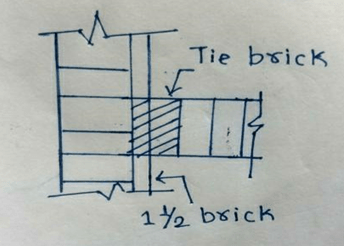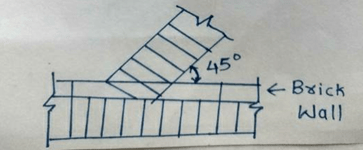This set of Construction and Building Materials Multiple Choice Questions & Answers (MCQs) focuses on “Brick Masonry – Bonds at Connections”.
1. A connection between a main wall and partition wall is termed as __________
a) Bond
b) Joint
c) Junction
d) Bed
View Answer
Explanation: In a Junction, the header course of the cross wall will enter the stretcher course of the main wall and the alternate course of the cross wall are simply abutting the main wall. Injunction is classified into two categories – right angled junction and squint Junction.
2. ________ type of right angle junction forms the shape of the English letter T in plan.
a) Tee-junction
b) Cross-junction
c) Squint junction
d) Brick junction
View Answer
Explanation: In Tee-junction, alternate courses of tee junction between one brick external wall and half brick internal wall, both the walls being constructed in English bond. One of the courses of the internal wall enters the stretcher course of the main wall, creating a lap of half brick.
3. A ___________ junction is formed when two continuous walls cross or intersect each other.
a) Squint junction
b) Cross-junction
c) Obtuse squint
d) Right angled junction
View Answer
Explanation: In Cross-junction or an Intersection, the alternate courses of the cross wall i.e. the courses of one of the walls simply butt against the courses of the other wall. Also, the alternate courses which are not continuous are provided with tie bricks in the form of key headers to create the necessary bond and lap.
4. A ________ is formed when two walls meet each other at an angle other than a right angle without making a quoin.
a) Cross-junction
b) Squint junction
c) Quoin
d) Intersection
View Answer
Explanation: Squint junction may be in the English bond and Flemish Bond. The Squint junction is however not common in brickwork and it is rarely adopted because great difficulties experience in accurately forming it in practice.
5. ________ form of quoin is formed when two walls meet at an angle of 90°.
a) Square quoin
b) Squint quoin
c) Acute quoin
d) Obtuse quoin
View Answer
Explanation: As the term implies, right-angled or square quoin is the form of quoin which is formed when two walls meet an angle of 90°. In right angled quoin, at the same level, header course on one face of angle is converted into a stretcher course on the other face of the angle. No vertical continuous joints are formed in this type of quoin.
6. A _________ is formed when a wall takes a turn and makes an angle other than a right angle.
a) Right angled junction
b) Acute squint
c) Squint quoin
d) Right angled quoin
View Answer
Explanation: In Squint quoin, the continuous straight joint should be avoided, the maximum length should be obtained with the maximum cutting of the bricks and the number of broken bricks to be used should be reduced to a minimum.
7. In ______ the in closed angle on the inside of the wall is less than a right angle.
a) Acute quoin
b) Acute squint
c) Squint quoin
d) Obtuse squint
View Answer
Explanation: In Acute squint, the enclosed angle on the inside of the wall is less than 90°. An acute squint can be in the form of an English bond or in the double Flemish bond.
8. In _________ the enclosed angle on the inside of the wall is between 90 degrees and 180 degrees.
a) Obtuse quoin
b) Acute squint
c) Acute quoin
d) Obtuse squint
View Answer
Explanation: In Obtuse squint, angle usually varies from 105° to 135°, the more common being 120°. An obtuse quint may be in the form of English bond or in the double Flemish bond. The walls in both the cases are of one and half times of brick thickness.
9. Identify the given figure below.

a) Tee junction
b) Cross junction
c) Quoin
d) Squint
View Answer
Explanation: Above given figure shows the plan of alternate courses of a Tee-junction between one and half bricks external wall and one brick internal wall, both the walls being constructed in the English bond. The header course of the internal wall enters the stretcher course of the main wall.
10. Identify the given figure below.

a) Tie junction
b) Right angled junction
c) Square quoin
d) Squint junction
View Answer
Explanation: Above given figure shows the plan of alternate courses of a Squint junction between one brick wall and one & half brick wall, both the walls being constructed in the English bond. The angle between the bond is 45°.
Sanfoundry Global Education & Learning Series – Construction and Building Materials.
To practice all areas of Construction and Building Materials, here is complete set of 1000+ Multiple Choice Questions and Answers.
If you find a mistake in question / option / answer, kindly take a screenshot and email to [email protected]
- Check Construction and Building Materials Books
- Check Civil Engineering Books
- Practice Civil Engineering MCQs
- Apply for Civil Engineering Internship
